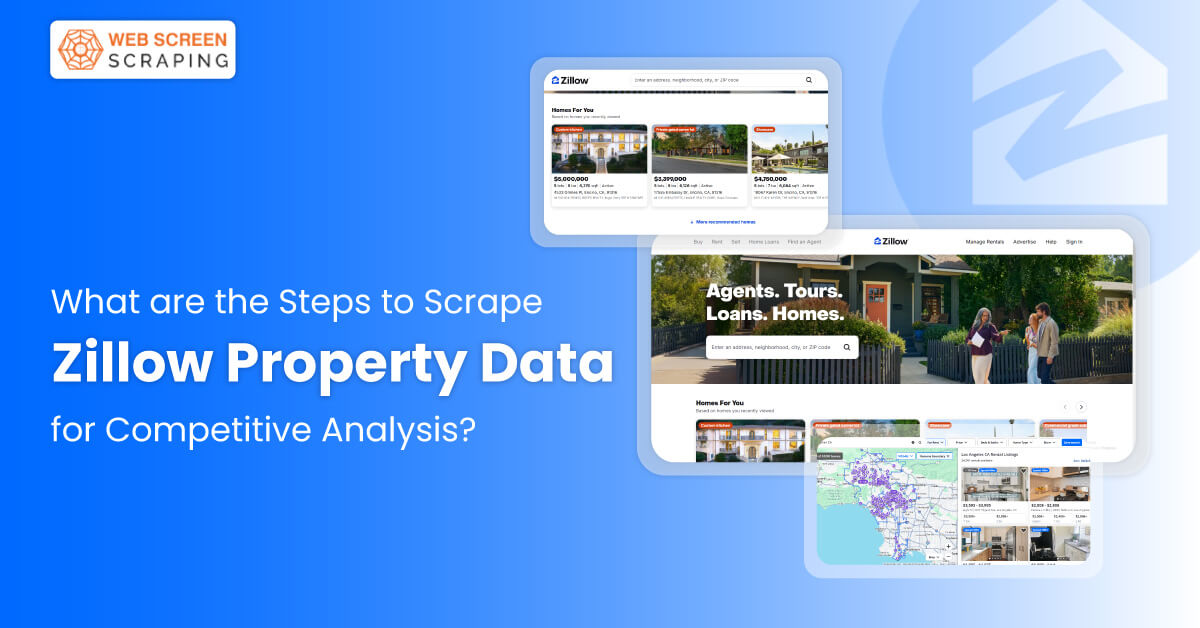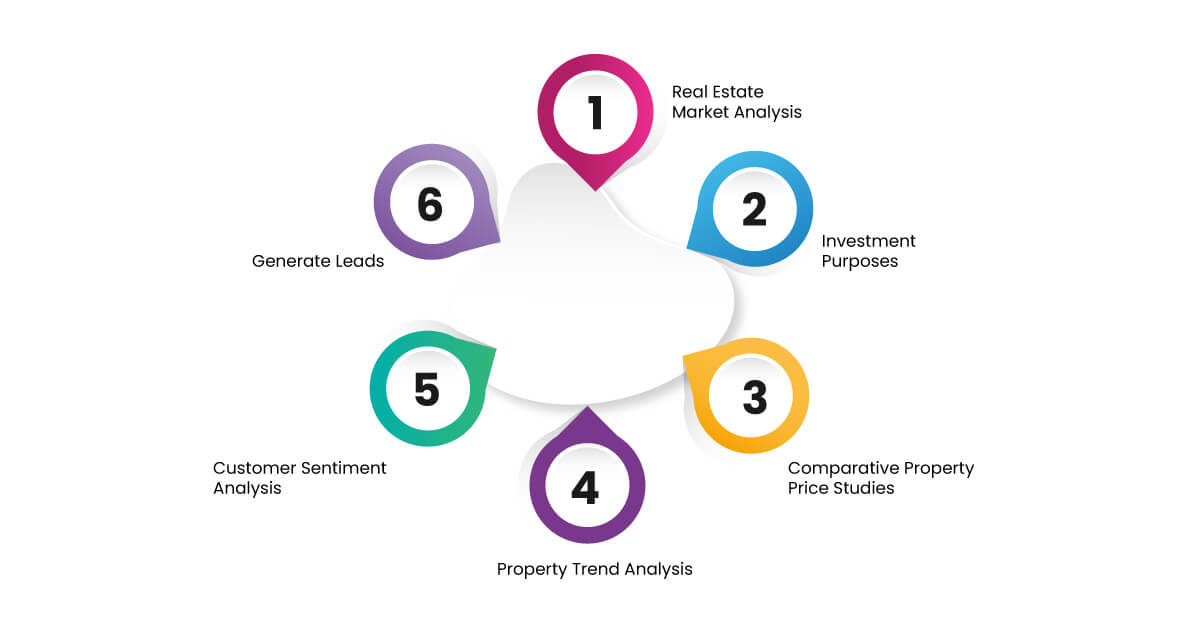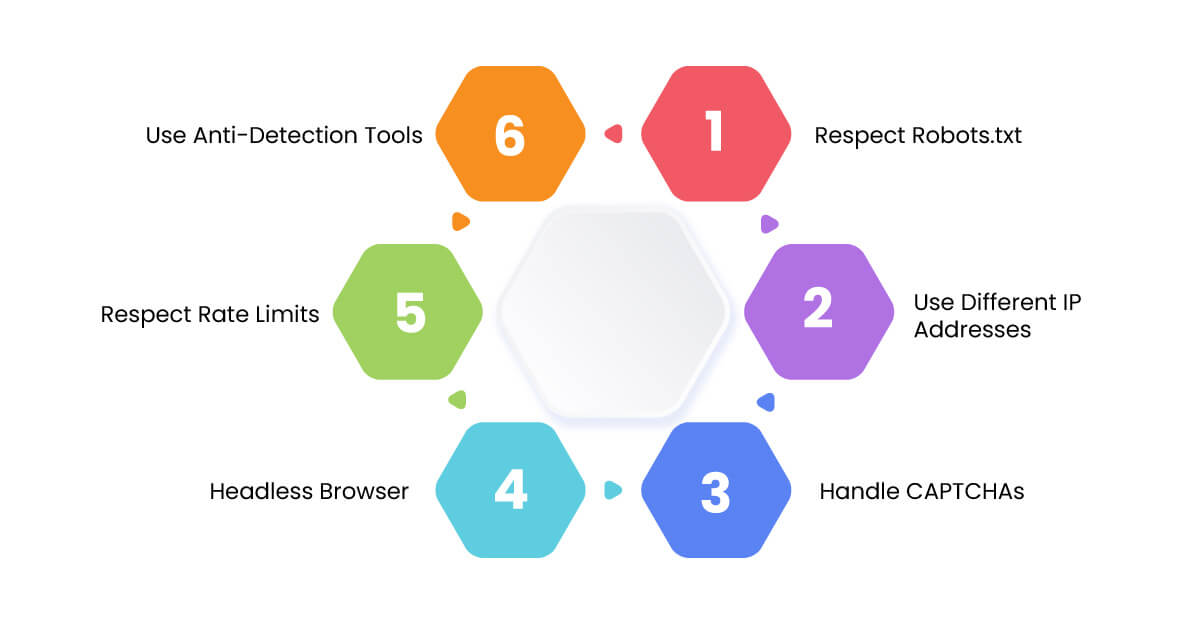
Zillow is one of the biggest online real-estate property platforms in the USA. Zillow gives detailed information on property prices, sales, purchase history, mortgages, rental properties, agent lists, and more. Zillow is an online real estate marketplace that started in 2006 and has increasingly grown popular among homebuyers, renters, and real estate agents. Zillow has a prominent feature known as Zestimate, which estimates property values based on data collected on the web and some user details. The Zestimate isn’t an official appraisal, but it helps buyers and sellers understand the home’s value. Also, a section on Zillow offers a calculator for mortgage costs, rental rate trends, and other information.
What is Zillow Data Scraping?
Zillow data scraping is extracting a large amount of data from Zillow’s real estate website using software applications or automated scripts. This information can be property listings, pricing, home, rental prices, trends, region-specific data and all the data that Zillow shares on its website. This data can be accessed for various reasons, such as performing industry analysis, investment analysis, price comparison, analysis of competitors, and forecasting trends in real estate.
Getting property data from the Zillow platform can be vital for data analysts, brokers, real estate developers, or marketers. Fetching Zillow data manually can be a time-consuming and tedious activity. Moreover, data taken manually will be outdated and not helpful for businesses to make real-time or profitable business decisions. It is advisable to utilize advanced technologies and tools to scrape Zillow real estate data in a real-time and accurate manner per business requirements. Today, in this blog, we will explore various methods that help scrape Zillow data. These techniques cover simple web scraping, automation tools, and APIs.
Why Scrape Zillow Data?

Scraping Zillow data can be useful in many ways for businesses, marketers, or developers operating in the competitive property market. Let’s examine how extracting Zillow data can be useful.
Real Estate Market Analysis
Extracting and collecting Zillow data can be useful in performing real estate market analysis. Varied datasets allow businesses or stockholders to run accurate analyses to determine market trends, new business opportunities, customer demands, competitor strategies, and more.
Investment Purposes
Zillow data lets you explore investment opportunities in the market. Analyzing region-wise data can help investors find better areas to invest in properties or developers build and sell properties profitably.
Comparative Property Price Studies
Property pricing data from Zillow helps to understand competitor property prices. Getting real-time pricing data will help to optimize one's own property prices to stay ahead of the competition. Historical pricing data will assist in determining the market price trend over a specific period.
Property Trend Analysis
Businesses can identify property trends in the market. Zillow data allows users to know which areas are in trend, what type of property is in demand, what the rental trend is in the market, and more.
Customer Sentiment Analysis
Property ratings and review data from Zillow help reveal what customers want. Performing sentiment analysis will assist in identifying customer views, facility requirements, in-demand areas, developer ratings, and more.
Generate Leads
Extracted property data from Zillow can be useful for identifying business leads. Perfect data analysis will help identify newly listed properties, price updates, and recent sales. With the help of Zillow data, businesses can contact property owners to execute profitable business deals.
Methods to Collect Property Datasets from Zillow
Explore the various methods to extract accurate property data from Zillow with ease.
Scrape Zillow Data with Python & BeautifulSoup
Python has multiple easy-to-use web scraping libraries along with detailed documents. Compared to other programming languages, Python provides greater flexibility to its users. Using Python will help you collect Zillow data quickly without facing any major technical issues.
BeautifulSoup (Python Library) is used to scrape and pull data from HTML and XML files. Combined with requests, you can easily extract property data from Zillow.
Requirements
- Python 3X
- requests library
- BeautifulSoup from bs4
Steps to Scrape Zillow Data
Install Required Libraries
python -m pip install requests bs4
Send Request to Zillow
url = 'https://www.zillow.com/los-angeles-ca/'
payload = {
'source': 'universal',
'url': url,
'user_agent_type': 'desktop',
'render': 'html',
'browser_instructions': [
{
'type': 'fetch_resource',
'filter': 'https://www.zillow.com/async-create-search-page-state'
}
]
}
Parse the HTML
Once you find the HTML content on the targeted page, it can be parse with BeautifulSoup.
# Extract property titles
property_titles = soup.find_all('h3', {'class': 'list-card-addr'})
for title in property_titles:
print(title.text)
Scrape Other Data
Extract various types of property data from Zillow, such as price, address, the number of bedrooms, facilities, and more, by inspecting the page elements with the use of proper selectors.
data = json.loads(response.json()['results'][0].get('content'))
listings = []
for listing in data['cat1']['searchResults']['mapResults']:
listing = {
'URL': 'https://www.zillow.com' + listing.get('detailUrl'),
'Address': listing.get('address'),
'Price': listing.get('price'),
'Status': listing.get('statusText'),
'Beds': listing.get('beds'),
'Baths': listing.get('baths'),
'Area (sqft)': listing.get('area'),
'Image': listing.get('imgSrc'),
'ZPID': listing.get('zpid')
}
listings.append(listing)
Scrape Zillow Data with Selenium (Browser Automation Method)
Another method to scrap data from Zillow is browser automation with selenium. Selenium tools and libraries make web scraping automation easy. It can work with multiple coding languages and is the preferred choice to scrape dynamic websites like Zillow.
Requirements
- Python 3X
- Selenium
- A WebDriver (like ChromeDriver or GeckoDriver)
Steps to Scrape Zillow using Selenium
Install Selenium
bash
pip install selenium
Download and Set Up a WebDriver
- Visit the official Selenium WebDriver website (https://www.selenium.dev/documentation/en/webdriver/driver_requirements/) to find the appropriate WebDriver for your browser.
- Download the WebDriver executable file for your operating system.
- Once downloaded, add the location of the WebDriver executable to your system’s PATH variable. This step ensures that Selenium can locate and use the WebDriver.
Automate Browser Interaction
python from selenium import webdriver from selenium.webdriver.common.by import By from selenium.webdriver.support.ui import WebDriverWait from selenium.webdriver.support import expected_conditions as EC
Next, initialize the WebDriver corresponding to your preferred browser:
python driver = webdriver.Chrome() # Change to the appropriate WebDriver (e.g., Firefox, Safari)
Use the get() method to open Zillow’s website:
python
driver.get("https://www.zillow.com")
python
price_element = WebDriverWait(driver, 10).until(
EC.visibility_of_element_located((By.CLASS_NAME, "listing-price"))
)
price = price_element.text
print("Price:", price)
Control Pagination
python next_button = WebDriverWait(driver, 10).until( EC.visibility_of_element_located((By.XPATH, "//a[contains(@class, 'pagination-next')]")) ) next_button.click()
Selenium Advantages
- Works perfectly with heavy web platforms and JavaScript.
- With the use of selenium, it is hard for the targeted platforms to detect automation.
- Selenium manages complex events such as scrolling, clicking buttons, or filling out forms very easily.
Selenium Challenges
- It processes slower than BeautifulSoup as it first loads the entire web page to work on.
- Requires setting up a browser and a WebDriver.
- Max risk of getting identified and blocked by Zillow.
Zillow Data APIs
Zillow does not provide an official API to collect data from the platform. However, multiple third-party Zillow data APIs are available to scrape the Zillow data.
Zillow API Access
XYZ Zillow API: Provided by a third party, the Zillow API offers access to Zillow data and lets you save as needed.
- Select Endpoint: /property
- Get detailed data such as property prices, address, and type.
- You may need to pay for higher usage.
import requests
url = "https://zillow-com1.p.xyz.com/property"
querystring = {"zpid":"2069719854"}
headers = {
"X-API-Key": "your_dapi_key",
"X-API-Host": "zillow-com1.p.xyzapi.com"
}
response = requests.get(url, headers=headers, params=querystring)
print(response.json())
API Advantages
- Easy to implement, connect and use.
- Get reliable data by staying within rate limits.
Challenges
- There may be charges from the service providers.
- There might be chances that data types can be limited compared to web scraping.
Manage Anti-Scraping Measures
As it has the largest amount of data, Zillow knows that it can be the targeted platform for real estate data scraping. Thus, Zillow implies multiple anti-scraping techniques to safeguard the platform data. The steps can be
- CAPTCHA implementation.
- IP blocking or rate-limiting.
- Use of JavaScrpit to load content dynamically.
How to Manage Anti-Scraping Measures
- Rotate proxies and distribute scraping requests across various IPs.
- Make proper delays between continuous requests to generate human browsing patterns.
- Minimize detection with the use of headless browsers.
- Use CAPTCHA solvers (like 2Captcha) for frequent CAPTCHA challenges.
Data Cleaning and Storage
After scraping Zillow data, the next method is to perform data cleaning and storage for further processing.
Data Cleaning:
- Remove unwanted characters, spaces, or HTML tags from the scraped text.
- Standardise formats for prices, addresses, and dates.
python
Copy code
# Cleaning up price data
cleaned_prices = [price.text.replace('$', '').replace(',', '') for price in property_prices]
Storage Options:
- Store data in a CSV file:
python
Copy code
import csv
with open('zillow_data.csv', 'w', newline='') as file:
writer = csv.writer(file)
writer.writerow(["Title", "Price"])
writer.writerows(zip(property_titles, cleaned_prices))
How to Scrape Zillow Real Estate Data Without Getting Blocked?

Web scraping Zillow can be an effective way to gather real estate data, but it must be done carefully to avoid being blocked and ensure an uninterrupted extraction process.
Respect Robots.txt
The robots.txt file in Zillow specifies the subsets of the Website that are readable by the bots and those that are not. Before scraping, always visit Zillow’s robots.txt to know which page you can scrape. You must also ensure you do not violate any ethical or legal bounds by accessing or visiting restricted areas.
Use Different IP Addresses
Zillow may block those appearing to make many requests from the same IP address for some reason. As an IP address works similarly to a digital postal address, one needs to swap them using services that deal with proxies. Residential proxies are almost perfect as they work like any ordinary internet user’s IP address, minimising the chances of identification.
Handle CAPTCHAs
Zillow may use CAPTCHAs to filter between a bot and a person. CAPTCHAs are the tasks that ensure that real users are sending the request. Either you can solve them mathematically manually, or there exists a service on the web that eliminates the burden of solving these problems. Even though CAPTCHAs are quite effective, you can reduce their frequency by scraping delicately and following standard user behavior patterns.
Headless Browser
Puppeteer or Selenium would be an example of a headless browser. This means that you can work with the website, yet there is no visible UI. These browsers closely resemble ordinary browsers but provide command-line interfaces, allowing the scraping of data from Zillow, where the tool wanders through various pages in a manner that mimics a human.
Respect Rate Limits
Many websites, including Zillow, restrict the number of calls that can be made at any one time or within a certain period. To be unblocked, be careful with your requests and do not exceed these limits. If you detect any blocking, take precautions and reduce your rate of requests.
Use Anti-Detection Tools
Several tools can easily mask the scraping requests and hence make them look more like those of any ordinary user. Certain anti-detection libraries or plugins that work with rendering stopping some browsing features that inform when one is scraping assist in evading detection mechanisms on Zillow.
Conclusion
Extracting property data from Zillow can deliver amazing benefits to real estate businesses. However, Scraping Zillow data also comes with many challenges, such as changing web structures, dynamic content, and anti-scraping mechanisms. You can choose the Zillow data scraping methods explained in this blog depending on your data needs. If you need large amounts of data, you can connect with Web Screen Scraping, a leading Zillow data scraping service provider.
While scraping data from Zillow yourself or using Zillow APIs, always ensure you follow the defined terms and conditions to mitigate legal issues. Also, always use the gathered data responsibly and ethically to comply with data protection guidelines.

